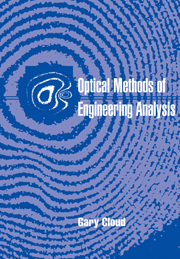Book contents
- Frontmatter
- Contents
- Acknowledgments
- 1 Introduction and orientation
- Part I Optics and interferometry
- Part II Photoelasticity
- Part III Geometrical moire
- Part IV Diffraction theory, optical processing, and moire
- Part V Moire interferometry
- Part VI Holographic interferometry
- Part VII Speckle methods
- 18 Laser speckle and combinations of speckle fields
- 19 Speckle photography
- 20 Speckle correlation interferometry
- 21 Electronic speckle pattern interferometry
- 22 Phase shifting to improve interferometry
- Author index
- Subject index
20 - Speckle correlation interferometry
Published online by Cambridge University Press: 12 January 2010
- Frontmatter
- Contents
- Acknowledgments
- 1 Introduction and orientation
- Part I Optics and interferometry
- Part II Photoelasticity
- Part III Geometrical moire
- Part IV Diffraction theory, optical processing, and moire
- Part V Moire interferometry
- Part VI Holographic interferometry
- Part VII Speckle methods
- 18 Laser speckle and combinations of speckle fields
- 19 Speckle photography
- 20 Speckle correlation interferometry
- 21 Electronic speckle pattern interferometry
- 22 Phase shifting to improve interferometry
- Author index
- Subject index
Summary
This chapter describes a way of using speckles that seems more elegant than speckle photography. A reference beam or a second speckle pattern is coherently mixed with the object speckle. The brightnesses of the resulting speckles are very sensitive to object motion. Comparison of two such patterns through superimposition or digital processing yields fringes indicative of displacement. The photograph-based version of the method is not used as much as speckle photography owing to experimental difficulties. Study of the method is worthwhile since it is the basis of electronic speckle pattern interferometry, which is becoming increasingly important.
Introduction
We turn now to what might be considered a more sophisticated use of speckle information in measurement. Rather than use a speckle merely as a marker on the specimen surface, we utilize to some extent the phase information within a speckle and the coherent combination of speckle fields as the basis of measurement. Such an approach is properly interferometric in concept and execution, so the techniques in this class are usually lumped together under the terms “speckle interferometry” or “speckle correlation interferometry” as distinct from “speckle photography.”
The somewhat confusing early history of these related but quite different techniques was presented in Chapter 19, so it will not be recapitulated here. The tutorial writings of Vest (1979), Ennos (1975), and Jones and Wykes (1983) are extremely useful from both the technical and historical viewpoints, as is the review by Stetson (1975).
One aspect of these techniques deserves special comment to preclude possible misunderstandings.
- Type
- Chapter
- Information
- Optical Methods of Engineering Analysis , pp. 440 - 452Publisher: Cambridge University PressPrint publication year: 1995
- 2
- Cited by

